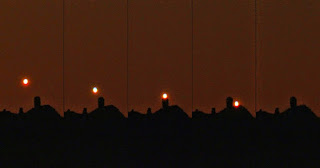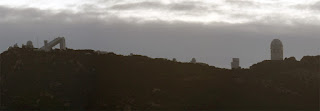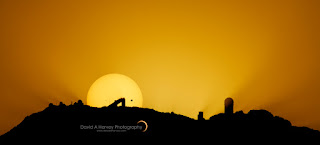 Most photographers are affected by the work of others. Whether consciously or unconsciously, you can see the results of others and modify techniques to use as your own. My friend and fellow blogger David Harvey, now gone for nearly 3 years, served as inspiration from his work and support from his comments on my own posts. Disguised as a mild-mannered software engineer, his real talent was photography, and he would likely be glad to know he still serves as inspiration from a shot like that at left - taken of the Venus transit of June, 2012, only a few months before his death from stomach cancer. An incredible shot, it is actually a composite of multiple exposures, one with the image of the sun with the black disk of Venus silhouetted against it, the second of the mountain profile of Kitt Peak National Observatory a minute later showing the crepuscular rays from the telescope domes. I like to think too that his idea to chase this shot came from my annual forays up Mount Lemmon to chase the sunset silhouette over Kitt Peak every Winter solstice. You see how it works - we all can learn from somebody! David's blog is still on the air - it is well worth your time to spend a few hours perusing his efforts in the above link.
Most photographers are affected by the work of others. Whether consciously or unconsciously, you can see the results of others and modify techniques to use as your own. My friend and fellow blogger David Harvey, now gone for nearly 3 years, served as inspiration from his work and support from his comments on my own posts. Disguised as a mild-mannered software engineer, his real talent was photography, and he would likely be glad to know he still serves as inspiration from a shot like that at left - taken of the Venus transit of June, 2012, only a few months before his death from stomach cancer. An incredible shot, it is actually a composite of multiple exposures, one with the image of the sun with the black disk of Venus silhouetted against it, the second of the mountain profile of Kitt Peak National Observatory a minute later showing the crepuscular rays from the telescope domes. I like to think too that his idea to chase this shot came from my annual forays up Mount Lemmon to chase the sunset silhouette over Kitt Peak every Winter solstice. You see how it works - we all can learn from somebody! David's blog is still on the air - it is well worth your time to spend a few hours perusing his efforts in the above link.Which leads us up to the present. In a couple weeks, Venus will again be at inferior conjunction, passing between us and the Sun. No transit across the face this time, in fact, it passes over 7 degrees south of the sun on 15 August. But even as Venus passed into the evening sky last Winter solstice, I had the idea to chase the crescent Venus over the Kitt Peak profile. At that excursion, Venus was shortly past Superior Conjunction, showing no disk or crescent, only an overexposed blob in the longer exposures needed to show the Kitt Peak domes, shown at left. Here, taken at 10 second intervals, Venus set behind the Observatory, here 55 miles away. Here we are, 8 months later at inferior conjunction, and the much larger crescent of Venus has a chance of being recorded over the Kitt Peak skyline!
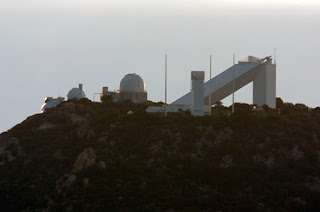 Dave's shot above shows what the size of Venus will display - since as it transits, it will be about the same size as inferior conjunction on the 15th. It should be a reasonable thing to record if the right spot can be found to set up. With that as motivation, Melinda and I hit the road last evening for a location scouting trip. Fortunately, south of the town of Three Points, there is a mostly north-south road with a good view of Kitt Peak to the west. I took a guess and set up at the turnoff to TR Ranch road about 15 miles south of Three Points. While the overhead sky was clear, there was a cloud behind the profile of Kitt Peak (of course!). And shown at left is a 4-frame panorama of the profile, taken with the TEC 140 telescope (about 1 meter focal length, 1,000mm). Only about 12 air miles away, good detail atop the mountain can be seen - witness the dome complex at left side of the above profile, here taken with the TEC with a 1.4X extender.
Dave's shot above shows what the size of Venus will display - since as it transits, it will be about the same size as inferior conjunction on the 15th. It should be a reasonable thing to record if the right spot can be found to set up. With that as motivation, Melinda and I hit the road last evening for a location scouting trip. Fortunately, south of the town of Three Points, there is a mostly north-south road with a good view of Kitt Peak to the west. I took a guess and set up at the turnoff to TR Ranch road about 15 miles south of Three Points. While the overhead sky was clear, there was a cloud behind the profile of Kitt Peak (of course!). And shown at left is a 4-frame panorama of the profile, taken with the TEC 140 telescope (about 1 meter focal length, 1,000mm). Only about 12 air miles away, good detail atop the mountain can be seen - witness the dome complex at left side of the above profile, here taken with the TEC with a 1.4X extender.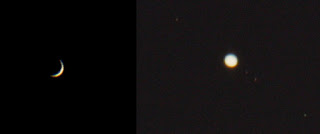 The image at left here showed our situation. Venus and Jupiter are still close together in the sky, now separated from their sub-degree conjunction what, almost 4 weeks ago. But the silhouette of Kitt Peak appears between them. From this exposure, I can guess where I should be later, depending on the motion of Venus. As the planets sank into the cloud bank, it looked as if the midpoint would have been right over the mountaintop.
The image at left here showed our situation. Venus and Jupiter are still close together in the sky, now separated from their sub-degree conjunction what, almost 4 weeks ago. But the silhouette of Kitt Peak appears between them. From this exposure, I can guess where I should be later, depending on the motion of Venus. As the planets sank into the cloud bank, it looked as if the midpoint would have been right over the mountaintop. Of course, despite the compulsory visit from the Border Patrol (accounting for about 80% of the evening traffic on this road), I got some snapshots of other targets. At right are shots of the crescent Venus (single shot, 640th second exposure) and Jupiter and its 4 Galilean moons (3 frame stack, 10th second exposure). Both are at full camera resolution, so relative sizes are maintained.
 And, of course, with the waxing gibbous moon high in the sky - I had to take an image of that too. With the 1.4X converter, the moon wouldn't quite fit in the field, so I took two offset frames and combined them in Photoshop, resulting in the image at left. It came out nicely given single exposures of 400th second each. Stacking frames would improve things, but since this was a fixed tripod, a tracking mount would ideally be needed.
And, of course, with the waxing gibbous moon high in the sky - I had to take an image of that too. With the 1.4X converter, the moon wouldn't quite fit in the field, so I took two offset frames and combined them in Photoshop, resulting in the image at left. It came out nicely given single exposures of 400th second each. Stacking frames would improve things, but since this was a fixed tripod, a tracking mount would ideally be needed.And, of course, with Photoshop out and warmed up, it was easy to simulate what Venus setting over the mountaintop might look like! At right is an image of Venus and an image of the south end of Kitt Peak overlaid on the same scale. Since I don't want to cause confusion, I've overlaid a label that this is a Photoshop creation, and not an actual single frame, which is ultimately my goal. It looks like a crescent moon hanging over the domes, but with a telescope from 12 miles, there is a chance of realizing something close to this.
There are 2 big problems to overcome. First, the composite image of the mountain was a .4 second exposure, and that of Venus was an 800th second. A properly exposed Venus requires a short exposure, so the solution to that is to take the image much closer or at sunset where there is more light. This will happen in a couple weeks closer to inferior conjunction. A close examination of Venus shows some atmospheric dispersion, which is normal, and would likely be a little greater in an actual single exposure, since this was taken when it was higher before disappearing into the cloud.
Likely the bigger problem is the time of year. In a couple weeks we're still in the middle of monsoon season, our cloudiest time of year, and the chances of clear sky are slim, particularly on a particular night. In addition, another scouting trip to verify an observing spot more accurately is needed - requiring a second clear night. Still possible, but chances might be better at the next inferior conjunction - that would be the end of March, 2017...

